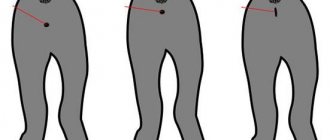Many people, if they want to have a pet, pay attention to cats. Simply because they are much less hassle than with a dog (you don’t need to walk them every morning), and for those who are constantly at work, this is the best option.
When faced with the dilemma of “he” or “she,” most give preference to the male gender: there will be no need to worry about when and how to shelter all the future descendants of the cat. While the kitten is small, the owners play carefree and enjoy the baby's daily playfulness.
But now the moment comes when there is a fear that the cat will grow into an adult, and as you know, the main instincts in such a period are to mark the territory and inform all the cats in the area that an adult cat lives here, ready to reproduce.
How do you know when it’s time to castrate a cat, what to look for, and is there an alternative to this method of getting rid of unwanted consequences?
Age of puberty in a cat
Many owners of furry pets are interested in the question of how to determine that it is time to neuter a cat, are there certain symptoms, what features in the cat’s behavior should you pay attention to? Puberty of a cat is around one year (7 - 11 months).
Since the characters of all pets are completely different, the period of full puberty may vary somewhat. So one may show a desire to continue procreation as early as 8 months, while the other will not show any signs even at one year. However, such a moment always comes unexpectedly for all owners.
Therefore, timely castration will help avoid an unwanted surge of hormones for the cat, and sleepless nights for its owners.
A whim or a vice: is it worth castrating a cat?
Since a pet becomes a full-fledged member of the family, with a procedure such as castration, a number of doubts and fears arise: will this cause harm to the mental and physical health of the cat? Existing frightening stories only aggravate the confusion of owners. Therefore, it is worth knowing such features as the advantages and disadvantages of castration.
Advantages of surgery:
- A castrated cat becomes balanced and calm;
- There are no screams in the middle of the night or in the morning;
- The pet sleeps more time;
- The wool becomes softer and brighter;
- Castration prolongs life;
- There is no risk of tumors and inflammation of the testicles and prostate.
Disadvantages of the procedure:
- At first, it is necessary to carefully monitor everything that your pet eats;
- Limit certain foods (fats, carbohydrates);
- It is necessary to administer anesthesia, after which the cat may feel unwell for about 14 hours;
- Hormonal levels change, which in turn can affect the proper production of uric acid. The result is urolithiasis.
Having weighed all the disadvantages and advantages, it is worth understanding that for those who do not want to forever put up with the unpleasant and persistent odors of their beloved pet, such a procedure is the only chance to avoid unwanted consequences in the future. After such a procedure, the cat’s owners bear the responsibility and understanding that it is now necessary to pay more attention to the cat’s proper and balanced nutrition.
Age restrictions or when it's time to castrate a cat
Determining when it is time to neuter a cat is quite simple. Due to the fact that the urge to procreate is always accompanied by a surge in hormone production, there are certain symptoms that can help determine the need to castrate a cat:
- Refusal to eat;
- Weight loss;
- Aggressiveness;
- Less sleep;
- Screams at doors and windows;
- Regular rubbing of the back of the back against jambs and sharp corners;
- Marking territory with enzymes;
- The desire to constantly sneak out of the apartment or house.
The first symptoms can rarely be noticed, attributing them to illness or weather conditions (heat), however, if the cat has already begun to mark territories and scream, then you should not bother going to the veterinarian even until the evening. After all, the persistent odor of enzymes not only smells bad, but is also difficult to get rid of.
If for some reason the cat could not be castrated before a year and a half, then you should not worry. This can be done until the pet is 3 years old.
Subsequently, such a procedure can be dangerous for the life and health of an adult cat with developed hormonal levels and habits.
It is worth remembering that it is best to undergo this procedure at an earlier age, even before the cat understands all the delights of adult life.
Source: https://vet-room.ru/koshki/107
What to feed
For a cat who has undergone anesthesia, diet is extremely important. The owner's task is to provide the pet with proper feeding in moderate quantities. Write down some useful tips for yourself that will help you get out of a serious postoperative condition:
- More meat feed. After castration, give boiled turkey, chicken or beef. Minimize portion sizes to avoid overloading your stomach.
- Dairy products. Introduce sour cream, kefir and cottage cheese into your diet. The fat content of these products should not exceed 5%.
- Dry food. Buy a package of Proplan, Hills or Royal Canin Premium food. Combine food with other foods to add variety to your diet.
- Fish. You should never forget about your favorite delicacy. Give your pet some fish at the end of each meal.
How a cat’s character changes after castration: the most interesting facts
One of the most common reasons for visiting a veterinarian is the desire to have your cat neutered.
Moreover, not in all cases do people want to interrupt the adventures of their pet among all the surrounding cats and its passionate cries.
Often, breeders want their pet to become more “friendly” and calm. How correct is this and how does a cat’s character actually change after castration?
About aggressive animals
Behavioral characteristics, although dependent to a certain extent on the level of sex hormones, are strictly individual. One important point that needs to be said right away.
Yes, over time your pet may become calmer, but this will not happen immediately. For the same Siamese, aggressiveness is a common character trait, and castration practically never corrects it. If a cat has a habit of hissing at its owner and scratching him, then sterilization alone will not cope with this.
However, in some cases, castration can actually have a significant impact on the character of the pet.
But this only happens in situations where the operation was performed before puberty.
Specific reflex arcs have not yet formed in the pet’s brain, and therefore it can actually grow up calmer when compared with non-castrated fellow tribesmen.
It is worth keeping in mind that all of the above, although completely fair, still does not apply to all cases.
Neutered cats still have certain social differences, sometimes very noticeable and significant. So, all cats by nature are pronounced predators.
And they, as you know, always strive to “reserve” a certain territory for themselves, for which they mark it and fight with other contenders for the place.
Castrated cats gradually lose their “possessive” feelings. They fight much less often with other animals, as their competitive instinct noticeably weakens. In addition, their desire to wander sharply decreases, because there is no longer a need to conquer “new territories” from competitors.
Please also note that the level of sex hormones (especially in the case of sterilization of an adult cat) does not fall immediately. A certain amount of them is always present in subcutaneous fat, mesenteric and internal fat; a certain amount of hormones may be present in the general bloodstream.
Consequences
As a rule, castration of animals takes place without negative consequences, but no veterinarian will give you a complete guarantee of the absence of complications. Each cat may have its own problems:
How to find out if a cat is neutered
Due to the fact that now in the world one can simply observe a global overpopulation of cats, each owner is simply obliged to be responsible for his animal, in particular for its castration.
A large number of owners (in particular male owners) believe that if their cat cannot have children (give birth), then it is not necessary to castrate him. But no one thinks about the fact that a cat can mate with other cats and thereby once again contribute to this very overpopulation.
But there are times when you are not completely sure whether a cat is neutered or not, so how do you know if a cat is neutered? The answer is simple - check!
Self-examination of the cat
So, you need to place the cat on the table in front of you in such a way that you have the opportunity to examine the buttock area, namely the genitals. Accordingly, the cat should stand with its back to you. It is necessary to raise the tail and carefully examine the genitals, and it is better to enlist someone’s help in case the cat decides to break free.
In order for this entire process to be as easy as possible, you need to constantly reassure your pet, pat him on the back and talk to him, including so that he lifts his tail and relaxes, then you won’t have to hold him.
Types of castration
Veterinary clinics have two options for “disabling” reproductive functions:
- Emasculation. A classic operation involving surgical removal of the testicles.
- Sterilization. A procedure in which the spermatic ducts are ligated. In this case, all organs and glands remain in their places.
As a rule, owners choose the traditional method, since after sterilization all the unpleasant consequences remain. The pet retains its sexual desire, it yells and shows aggressiveness. Some pet lovers believe that testicular amputation is dangerous, but experts assure that there is nothing wrong with it. With proper care, you will not have to worry about the sutures becoming swollen. Complications occur extremely rarely, in unforeseen cases.
How much does castration of a cat cost - when to castrate a cat and where to castrate a cat?
- Keeping pets can be challenging in a variety of ways.
- For example, at some point your male cat may need to reproduce, which is not always pleasant for the breeder.
- Veterinary hospitals recommend surgery to castrate or sterilize your pet. This procedure will eliminate the animal’s attraction to the opposite sex, as well as make life easier for their owners.
What is the essence of the operation
Sterilization is an operation in which the surgeon removes either the uterus and ovaries, or only the ovaries, as the owner wishes.
The first option is better, as it guarantees the absence of health problems in this area in the future.
If only the ovaries are removed during surgery, the cat may develop a disease in the future, which will require the procedure to be repeated.
Also, with the second version of the operation, there is no guarantee that the pet will not become pregnant or lose sexual desire. If the owner decides to sterilize his pet, it is better to completely remove the internal reproductive organs, which will protect the animal from diseases and the owners from unexpected feline offspring.
Such operations are carried out using two methods. The first is an incision in the abdominal area along the lateral muscle, removing one ovary in this place, since the approach to the other side is difficult. Surgeons prefer to cut along the linea alba. This reduces bleeding, which makes it possible to immediately remove the uterus and reproductive organs.
Castration is an operation for male animals during which the testes are removed. The procedure lasts about ten minutes and is performed under general anesthesia. Cats require three weeks of care after surgery, but the cat should be kept away from various heights until the anesthesia wears off.
How much does castration and sterilization cost?
Depending on the type of operation, the reputation of the hospital and the place where the procedure is performed, the cost ranges from 1500-2000 rubles in standard budget organizations and within 7000 rubles in private clinics. Some veterinarians perform castration at home, and this already increases the price of the service.
Description of the procedure and indications for it
Most owners do not have an accurate definition of castration because they do not have a medical education. Many people think that castration is an operation for cats, and sterilization is for cats. However, both procedures can be applied to an animal regardless of gender.
When castrating, the glands and organs of the reproductive system that facilitate reproduction are completely or partially removed from an animal. In cats, these are the testes of the ovaries; in cats, in addition to the testes, the uterus can be cut out in the egg. At the same time, sexual desire is suppressed and the behavior of the animal changes.
During sterilization, the cat's fallopian tubes are ligated, and the cat's spermatic duct is ligated. The sexual function itself does not lose its strength, which causes new urges in animals to mate.
Both procedures - serious surgery and a cat after castration
requires special care, the use of a number of medications and, in principle, requires full post-operative recovery.
Few of the “cat people,” both supporters of this procedure and its irreconcilable opponents, remember that this operation, in addition to the behavior of the animal and the exhaustion of the owners, also has absolutely medical indications.
An animal needs castration in the following cases:
- prostate cancer or other tumors in the genital organs;
- testicular injuries;
- urolithiasis disease;
- diseases of a genetic nature.
If there are no medical indications for surgery, but there is a desire to castrate the cat to “prevent” the same urolithiasis, which is, in principle, very controversial, but nevertheless accepted, this must be done before 8 months, that is, before the onset of puberty. In this case, the animal will not initially demand the cat and mark its territory.
The procedure itself is not as complicated and bloody as opponents of castration describe; it is no different from what, for example, the Turks and Arabs did when they “produced” eunuchs for harems, or the Chinese emperors and clergy of the Vatican, trying to provide the choir with unusual male timbres , inherent in children.
Both the operation in the clinic and the procedure at home have their advantages; if the animal is castrated at the age of, for example, three years, then you need to go to the hospital. The same applies to cats undergoing the procedure out of necessity.
Video:
If you want to find out in detail how cats are castrated, watch the video below. He clearly demonstrates all stages of testicular removal, from preparation to suturing the incisions. During this process, specialists explain every action the surgeon takes so that people clearly understand what the operation entails.
Since there is such a significant overpopulation of cats in the world, neutering a cat should be the responsibility of a responsible owner. Many male owners do not neuter their cats because they believe that since their cat will not have kittens, it is not necessary. However, your cat may mate with cats, thereby contributing to the overpopulation. But if you have adopted an adult cat and are not sure whether he has been neutered, you can check for yourself.
Steps
Part 1 Self-examination of the cat
- 1 Place the cat.
In order to examine your cat yourself, you will need to gain access to his buttock area to look at the genitals. You must place the cat with its back facing you. After this, you should lift his tail up to see the genital area. You may need help if you think your cat might start fidgeting during this.- You can start patting your cat on the back and talk to him so that he raises his tail on his own. This way you won't have to hold him and he will be more relaxed.
- Since you will be feeling your cat's genitals, it is a good idea to wear latex gloves. The main thing is that the gloves are thin enough so that you can feel something through them.
- 2 Remove fur if necessary.
If your cat is furry, you may need to brush the excess fur to the side to be able to see the genitals. Remove the fur to reveal the genitals. Once you part the fur between his paws, you will see his penis and anus.- The main thing is to be careful not to press too hard, otherwise you may hurt the cat.
- If you have a short-haired cat, then you won't need this step, as his genitals will be visible without the need to part the fur.
- If your cat is quiet and docile, then you can examine him by laying him on his back. If you want to do this, then grab the scruff of his neck and turn him over. This will help keep him in place and protect your hands and arms in case he attacks you with his claws.
- 3 Examine the testicles.
When a cat is neutered, his testicles are removed. Because of this, if the cat has been neutered, you will be able to feel it. Take a look at his scrotum, which is located under his tail and anus and above his penis. There should be a small bag here. Take it in your hands and carefully feel it. If you feel hard testicles, your cat still has testicles and has not been neutered. If the pouch is soft, he was most likely recently neutered. In this case, the cat's scrotum is usually shaved.- If there is no pouch at all, it is possible that he was neutered more than a month ago and the pouch simply deflated.
- If you find one testicle, it means your cat has not been neutered.
- All this does not give a 100% guarantee that your cat has been neutered. If your cat is still young, his testicles may simply not have descended yet. There is also a chance that your cat suffers from cryptorchidism, a condition in which the testicles do not descend into the scrotum.
- 4 Measure the distance between the anus and penis.
There is another way to check if your cat has been neutered. Pick up his tail. Measure the distance between his anus and tail. If the distance is more than 2.5 cm, then most likely your cat has been neutered.- If your cat is still small, the distance should be a little more than 1.25 cm.
Part 2 Alternative verification methods
- 1 Look in the records.
When you buy or adopt a cat or kitten, find out if there are any accompanying documents that come with it. This could be a certificate or letter from a veterinarian confirming the cat's castration.- Don't be afraid to ask questions like these. If you buy a cat from a pet store or agency and they don't give you any paperwork, ask them if your new cat has been neutered. This is not an indiscreet question and will make you appear more responsible as an owner.
- 2 Look at his ears.
If you have received or found a stray cat and do not have any information about it, check its inner ear for marks. Look for markings or signs of cropped ears. These signs usually mean that the cat has been neutered.- There is one mark that does not mean that the cat has been neutered. If you see the letter M, it means the cat has micro-chips.
- 3 Look at the fur on the underbelly.
When you pick up your cat, look at his fur on his lower abdomen. If the fur is shaved or appears shorter, the cat may have been neutered. Veterinarians must shave the fur in this area before performing neutering, so this can be a sign.- This method is not completely correct, so you should try other methods in addition to it.
- 4 Ask your veterinarian.
If you have tried every possible method and are still not sure, then ask your veterinarian if your cat has been neutered. Your veterinarian will be able to tell you this for sure, as they may be able to test things on your cat that you might not know about.- Let your veterinarian be clear about your concerns. If you find out that your cat is not neutered, make an appointment to have the surgery done as soon as possible.
Home » Hip » What a cat looks like after castration. How to distinguish a cat from a cat: signs that help determine gender
Behavior
When the anesthesia wears off, the cat will feel that there is nothing left where he had eggs before. The state of shock will last for several days. Your task is to constantly pay attention to the cat. Take your pet in your arms, play and talk to him. The owner's voice has a calming effect. Familiar intonations provide a feeling of security.
A week after the operation, the pet will return to a normal lifestyle, but much of its behavior will change. Uncastrated animals feel sexual desire, and therefore often ask to go outside. Castrated cats concentrate more on communicating with humans. They become balanced and calm, but at the same time continue to show interest in toys.











